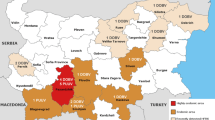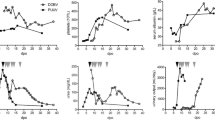Abstract
The European prototype of hantavirus, Puumala virus (PUUV), isolated from a common wild rodent, the bank vole (Myodes glareolus), causes nephropathia epidemica (NE). NE can perfectly mimic haemolytic-uraemic syndrome (HUS), progressing from an aspecific flu-like syndrome to acute kidney injury with thrombocytopaenia, and presenting with some signs of haemolytic anaemia and/or coagulopathy. Moreover, both NE and HUS can occur in local outbreaks. We report an isolated case of NE, initially referred for plasmapheresis for suspected HUS, although signs of overt haemolysis were lacking. Early suspicion of hantavirus infection, later confirmed by serology and reverse transcription polymerase chain reaction (RT-PCR), prevented subsequent excessive treatment modalities.


Similar content being viewed by others
References
Vaheri A, Henttonen H, Voutilainen L, Mustonen J, Sironen T, Vapalahti O (2013) Hantavirus infections in Europe and their impact on public health. Rev Med Virol 23(1):35–49. https://doi.org/10.1002/rmv.1722
Clement J, Maes P, Van Ranst M (2007) Acute kidney injury in emerging, non-tropical Infections. Acta Clin Belg 62(6):387–395
Clement J (2015) Acute kidney injury and hantavirus disease. In: Turner NN, Lameire N, Goldsmith DJ, Winearls CG, Himmelfarb J, Remuzzi G (eds) Oxford textbook of clinical nephrology, 4th edn. Oxford University Press, Oxford, pp 2059–2066. ISBN-13: 978-0199592548
Keyaerts E, Ghijsels E, Lemey P, Maes P, Zachée P, Daelemans R et al (2004) Plasma exchange-associated immunoglobulin M-negative hantavirus disease after a camping holiday in southern France. Clin Infect Dis 38(10):1350–1356. https://doi.org/10.1086/383311
Collective STEC Workshop Reporting Group (2012) Experiences from the Shiga toxin-producing Escherichia coli O104:H4 outbreak in Germany and research needs in the field, Berlin, 28–29 November 2011. Euro Surveill 17(7). pii: 20091. Available online at: http://www.eurosurveillance.org/ViewArticle.aspx?ArticleId=20091
Kitterer D, Segerer S, Alscher MD, Braun N, Latus J (2015) Puumala hantavirus-induced hemorrhagic fever with renal syndrome must be considered across the borders of nephrology to avoid unnecessary diagnostic procedures. PLoS One 10(12):e0144622. https://doi.org/10.1371/journal.pone.0144622
Maes P, Wambacq J, Van Ranst M, Clement J (2010) Chapter 60. Puumala virus. In: Liu D (ed) Molecular detection of human viral pathogens. CRC Press, Boca Raton, pp 667–676. ISBN: 978-1-4398-1236-5
Maes P, Clement J, Gavrilovskaya I, Van Ranst M (2004) Hantaviruses: immunology, treatment, and prevention. Viral Immunol 17(4):481–497. https://doi.org/10.1089/vim.2004.17.481
Hayasaka D, Maeda K, Ennis FA, Terajima M (2007) Increased permeability of human endothelial cell line EA.hy926 induced by hantavirus-specific cytotoxic T lymphocytes. Virus Res 123(2):120–127. https://doi.org/10.1016/j.virusres.2006.08.006
Terajima M, Ennis FA (2011) T cells and pathogenesis of hantavirus cardiopulmonary syndrome and hemorrhagic fever with renal syndrome. Viruses 3(7):1059–1073. https://doi.org/10.3390/v3071059
Laine O, Mäkelä S, Mustonen J, Huhtala H, Szanto T, Vaheri A et al (2010) Enhanced thrombin formation and fibrinolysis during acute Puumala hantavirus infection. Thromb Res 126(2):154–158. https://doi.org/10.1016/j.thromres.2010.05.025
Mantula PS, Outinen TK, Clement JPG, Huhtala HSA, Pörsti IH, Vaheri A et al (2017) Glomerular proteinuria predicts the severity of acute kidney injury in Puumala hantavirus-induced tubulointerstitial nephritis. Nephron 136:193–201. https://doi.org/10.1159/000459634
Rasmuson J, Andersson C, Norrman E, Haney M, Evander M, Ahlm C (2011) Time to revise the paradigm of hantavirus syndromes? Hantavirus pulmonary syndrome caused by European hantavirus. Eur J Clin Microbiol Infect Dis 30(5):685–690. https://doi.org/10.1007/s10096-010-1141-6
Clement J, Maes P, Lagrou K, van Ranst M, Lameire N (2013) A unifying hypothesis and a single name for a complex globally emerging infection: hantavirus disease. Eur J Clin Microbiol Infect Dis 31(1):1–5. https://doi.org/10.1007/s10096-011-1456-y
Clement J, Maes P, Van Ranst M (2014) Hemorrhagic fever with renal syndrome in the new, and Hantavirus Pulmonary Syndrome in the old world: paradi(se)gm lost or regained? Virus Res 187:55–58. https://doi.org/10.1016/j.virusres.2013.12.036
Vollmar P, Lubnow M, Simon M, Müller T, Bergler T, Alois P et al (2016) Hantavirus cardiopulmonary syndrome due to Puumala virus in Germany. J Clin Virol 84:42–47. https://doi.org/10.1016/j.jcv.2016.10.004
Van Loock F, Thomas I, Clement J, Ghoos S, Colson P (1999) A case–control study after a hantavirus infection outbreak in the south of Belgium: who is at risk? Clin Infect Dis 28:834–839
Tervo L, Mäkelä S, Syrjänen J, Huttunen R, Rimpelä A, Huhtala H et al (2015) Smoking is associated with aggravated kidney injury in Puumala hantavirus-induced haemorrhagic fever with renal syndrome. Nephrol Dial Transplant 30:1693–1698. https://doi.org/10.1093/ndt/gfv273
Koster F, Foucar K, Hjelle B, Scott A, Chong YY, Larson R et al (2001) Rapid presumptive diagnosis of hantavirus cardiopulmonary syndrome by peripheral blood smear review. Am J Clin Pathol 116(5):665–672. https://doi.org/10.1309/CNWF-DC72-QYMR-M8DA
Denecke B, Bigalke B, Haap M, Overkamp D, Lehnert H, Haas CS (2010) Hantavirus infection: a neglected diagnosis in thrombocytopenia and fever? Mayo Clin Proc 85(11):1016–1020. https://doi.org/10.4065/mcp.2009.0040
Outinen TK, Mäkelä S, Clement J, Paakkala A, Pörsti I, Mustonen J (2015) Community acquired severe acute kidney injury caused by hantavirus-induced hemorrhagic fever with renal syndrome has a favorable outcome. Nephron 130:182–190. https://doi.org/10.1159/000433563
Gizzi M, Delaere B, Weynand B, Clement J, Maes P, Vergote V et al (2013) Another case of “European hantavirus pulmonary syndrome” with severe lung, prior to kidney, involvement, and diagnosed by viral inclusions in lung macrophages. Eur J Clin Microbiol Infect Dis 32(10):1341–1345. https://doi.org/10.1007/s10096-013-1885-x
Antonen J, Leppänen I, Tenhunen J, Arvola P, Mäkelä S, Vaheri A et al (2013) A severe case of Puumala hantavirus infection successfully treated with bradykinin receptor antagonist icatibant. Scand J Infect Dis 45(6):494–496. https://doi.org/10.3109/00365548.2012.755268
Author information
Authors and Affiliations
Corresponding author
Rights and permissions
About this article
Cite this article
Clement, J., Lee, A.P.K., Verpooten, G.A. et al. Acute hantavirus infection presenting as haemolytic-uraemic syndrome (HUS): the importance of early clinical diagnosis. Eur J Clin Microbiol Infect Dis 37, 135–140 (2018). https://doi.org/10.1007/s10096-017-3113-6
Received:
Accepted:
Published:
Issue Date:
DOI: https://doi.org/10.1007/s10096-017-3113-6




